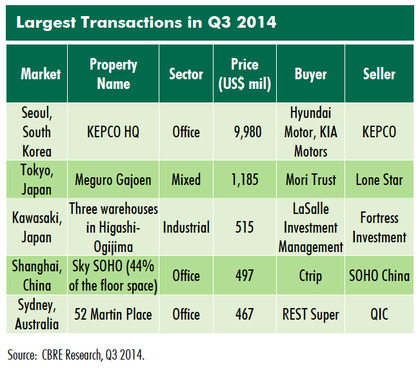The WPJ
THE WORLD PROPERTY JOURNALReal Estate Facts Not Fiction
Commercial Real Estate News

Institutional Investment in Asia-Pacific Property Markets Spike 40 Percent
Commercial News » Hong Kong Edition | By Michael Gerrity | November 10, 2014 9:30 AM ET
According to global real estate consultant CBRE, the third quarter of 2014 saw the completion of four large transactions worth over $500 million each, pushing up total real estate investment volume in Asia Pacific to $35 billion, an increase of 40% quarter-on-quarter. Particularly strong activity was recorded in South Korea, Japan and Australia. Cross-border investment activity in the region has remained lively and totaled $16 billion for the first nine months of 2014, an increase of 20% year-on-year.
 CBRE's Managing Director of Capital Markets, Greg Penn commented, "Looking ahead, we expect to see an active market during the remainder of the year, with Japan and Australia showing a strong flow of deals. Investor sentiment is also increasing in emerging markets in Southeast Asia and India, particularly in Vietnam as their economy recovers and prices display growth. With India, we see that more foreign investors are taking an interest in the form of joint ventures with local groups. Business confidence has improved in India following the new election of a new government in May.
CBRE's Managing Director of Capital Markets, Greg Penn commented, "Looking ahead, we expect to see an active market during the remainder of the year, with Japan and Australia showing a strong flow of deals. Investor sentiment is also increasing in emerging markets in Southeast Asia and India, particularly in Vietnam as their economy recovers and prices display growth. With India, we see that more foreign investors are taking an interest in the form of joint ventures with local groups. Business confidence has improved in India following the new election of a new government in May.Meanwhile, Q3 saw newly formed private equity real estate funds turn more active in expanding their portfolio, with additional funds expected to complete their fund raising activity by year end. Several major deals are expected to be completed as international institutional investors continue to display a strong appetite for core assets."
Other key highlights include:
-
 In Q3, South Korea saw the largest ever commercial real estate transaction in Asia Pacific--a $10 billion acquisition of the KEPCO headquarters in Seoul by Hyundai Motor Company and KIA Motors--pushing up the quarterly turnover to the highest level recorded since 2005. Excluding this deal, transaction volume was similar to that which was recorded in Q2.
In Q3, South Korea saw the largest ever commercial real estate transaction in Asia Pacific--a $10 billion acquisition of the KEPCO headquarters in Seoul by Hyundai Motor Company and KIA Motors--pushing up the quarterly turnover to the highest level recorded since 2005. Excluding this deal, transaction volume was similar to that which was recorded in Q2.
- Strong investment activity continued in Japan, where transaction volume rose significantly due to the large yield spread over the lending rate and fluid lending environment. Elsewhere, China's activity was driven by acquisitions by owner-occupiers and dispositions by property companies.
- Office leasing momentum is generally improving but occupiers remain cost conscious and core location demand is supported by flight-to-quality activity. The improving occupier market supported further growth in office prices this quarter. The CBRE Asia Pacific Office Capital Value Index increased by 1.7% quarter-on-quarter in Q3 2014, compared to a rise of 0.6% in Q2 2014. Price growth was led by Tokyo--up by 8.1% quarter-on-quarter--as well as growth being recorded in Australia and New Zealand.
- Australia and Japan recorded strong investment demand for retail assets, as both markets continued to see robust expansionary activity from international retailers. In Japan, investors are seeking opportunities in regional cities as retailers expand outside Tokyo. This pushed up the CBRE Asia Pacific Retail Capital Value Index by 1.9% quarter-on-quarter, a rise driven exclusively by Tokyo, Sydney and Melbourne. On the other hand, investor sentiment in Greater China and Singapore remains weak.
- Meanwhile, logistics remains a hot sector; transaction volume in this sector surged by 53% quarter-on-quarter to $4.8 billion in Q3 2014, which was mainly led by industrial-focused J-REITs expanding their portfolios through acquisitions in Japan.
Senior Director of CBRE Research, Ada Choi also commented, "Overall, investment activity will be supported by high liquidity, particularly in mature markets benefiting from low interest rates and increased leveraging. However, the current pricing is barely supported by the weak recovery in rental growth in some parts of the region.
Investors are now being more patient in searching for more viable investment opportunities. Besides core assets, investors are also looking more closely at secondary assets and value-added strategies, such as asset enhancement in order to capture upgrading occupier demand and higher expected return."
Sign Up Free | The WPJ Weekly Newsletter
Relevant real estate news.
Actionable market intelligence.
Right to your inbox every week.
Real Estate Listings Showcase
Related News Stories
Commercial Real Estate Headlines
- 2025 Prediction: U.S. Commercial Investment Recovery Expected to Gain Traction
- Holiday Retail Sales for 2024 to Hit Record $1 Trillion
- Tech, AI Industries Drive Largest Share of Office Leasing Activity in U.S.
- Commercial Real Estate Lending in U.S. Enjoys Strong Growth in Q3
- U.S. Multifamily Market Begins Recovery in Q3
- Commercial Investment in Japan Spikes 24 Percent Annually in Q3
- Despite Return-to-Office Mandates, U.S. Office Vacancies Continue to Rise
- PROPSIG Tech Startup Acquired by World Property Data
- U.S. Commercial Mortgage Debt Hits $4.7 Trillion in Q2 as Delinquencies Increase
- Hong Kong Class A Office Rents Continue to Downtick in Mid-Summer
- U.S. Office Landlords Tenant Concessions Decline for First Time in 4 Years
- U.S. Commercial Mortgage Originations Spike 27 Percent in Q2 Over Q1
- Phnom Penh's Commercial Office, Retail Markets Face Slowdowns in 2024
- Global Edge Data Center Market to Hit $300 Billion by 2026
- Commercial Property Transactions in Japan Dive 25 Percent Annually in Q2
- Delinquency Rates for U.S. Commercial Property Loans Downticks in Q2
- Megawarehouse Lease Deals in U.S. Increase in 2024
- Office Tenants' Flight to Quality Buildings Increases in 2024
- Commercial Lending in Japan Upticks 6 Percent Annually in Q1
- AI Driving Significant Global Data Center Growth in 2024
- Total U.S. Commercial Mortgage Debt Rises to $4.7 Trillion in Q1
- U.S. Commercial Mortgage Delinquencies Rise in Early 2024
- Asia Pacific Office Sector to Further Reprice Throughout 2024
- U.S. Retail Foot Traffic to Surpass Pre-Pandemic Levels by 2025
- Commercial Real Estate Lending in U.S. Slowed in First Quarter
- Japan Commercial Property Investment Volume Jumps 7 Percent in Q1
- Asia Pacific Commercial Property Investment Leads the World, Spikes 13 Percent
- Driven by High Rates, U.S. Commercial Lending Imploded 47 Percent in 2023
- After Two Year Slump, Prime Multifamily Metrics Uptick in U.S.
- Commercial Co-Broker Commissions Not Affected by NAR-DOJ Settlement, Yet
- U.S. Office Buildings with Upscale Tenant Amenities Still Enjoy Premium Rents in 2024
- U.S. Commercial, Multifamily Mortgage Delinquency Rates Uptick in Q4
- U.S. Commercial Mortgage Debt Continued to Rise in 2023, Hits $4.7 Trillion
- Nonresidential Construction Spending in the U.S. Falls Sharply in January
- U.S. Multifamily Construction Starts to Decline in 2024
- Commercial Mortgage Lending in U.S. Shows Signs of Stabilization in Late 2023
- Architecture Billings Decline in December as Soft Business Conditions Persist
- Government Sector Claimed Largest Portion of 100 Biggest U.S. Office Leases Signed in 2023
- U.S. Commercial, Multifamily Borrowing Dives 25 Percent Annually in Late 2023
- Record High Multifamily Construction Deliveries Drive Vacancy Rates Higher
Reader Poll
Marketplace Links
This website uses cookies to improve user experience. By using our website you consent in accordance with our Cookie Policy. Read More





